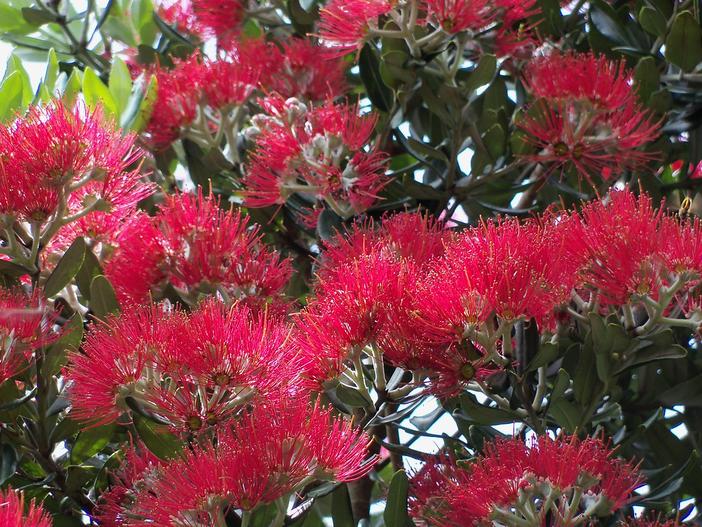Pohutukawa
(Metrosideros excelsa)
Pohutukawa (Metrosideros excelsa)
/
/

Wylie
CC BY 2.0
Image By:
Wylie
Recorded By:
Copyright:
CC BY 2.0
Copyright Notice:
Photo by: Wylie | License Type: CC BY 2.0 | License URL: https://creativecommons.org/licenses/by/2.0/ | Uploader: Wylie-Young | Publisher: Flickr




































































































Estimated Native Range
Summary
Metrosideros excelsa, commonly known as Pohutukawa, is an evergreen tree native to coastal regions and cliffs of the North Island of New Zealand. It is a member of the myrtle family, Myrtaceae, and is renowned for its resilience and striking appearance. Pohutukawa can reach up to 25 meters (82 ft) in height and has a spreading, dome-like form, often with multiple trunks. The tree’s trunks and branches may be adorned with matted, fibrous aerial roots. Its oblong, leathery leaves have dense white hairs on the underside, contributing to its unique texture. The Pohutukawa is celebrated for its profusion of red flowers, which bloom from November to January, peaking in early summer. The flowers’ mass of stamens creates a vibrant display, earning it the nickname "New Zealand Christmas tree."
The Pohutukawa tree is valued for its showy crimson flowers and its ability to thrive in challenging conditions, making it a symbol of strength and beauty in New Zealand culture. It is commonly used in urban planting and as a lawn tree in coastal California, despite concerns over its aggressive root system. For successful cultivation, it prefers full sun to part shade, moderate watering, and well-drained soils. While it is easy to grow, gardeners should be aware of its potential to damage infrastructure with its roots.CC BY-SA 4.0
The Pohutukawa tree is valued for its showy crimson flowers and its ability to thrive in challenging conditions, making it a symbol of strength and beauty in New Zealand culture. It is commonly used in urban planting and as a lawn tree in coastal California, despite concerns over its aggressive root system. For successful cultivation, it prefers full sun to part shade, moderate watering, and well-drained soils. While it is easy to grow, gardeners should be aware of its potential to damage infrastructure with its roots.CC BY-SA 4.0
Plant Description
- Plant Type: Tree
- Height: 20-35 feet
- Width: 15-20 feet
- Growth Rate: Moderate
- Flower Color: Red
- Flowering Season: Spring, Winter
- Leaf Retention: Evergreen
Growth Requirements
- Sun: Full Sun, Part Shade
- Water: Medium
- Drainage: Slow, Medium, Fast
Common Uses
Bee Garden, Bird Garden, Butterfly Garden, Hummingbird Garden, Low Maintenance, Salt Tolerant, Showy Flowers, Street Planting
Natural Habitat
Coastal regions and cliffs of the North Island of New Zealand
Other Names
Common Names: New Zealand Christmastree, New Zealand Christmas Tree, Iron Tree, New Zealand Christmas Bush, Nieu-Seelandse Perdestert, New Zealand Christmas Tree
Scientific Names: , Metrosideros excelsa, Metrosideros tomentosa, Nania tomentosa,
GBIF Accepted Name: Metrosideros excelsa Sol. ex Gaertn.